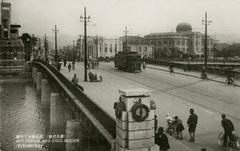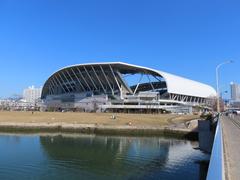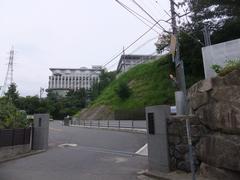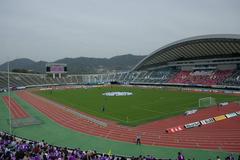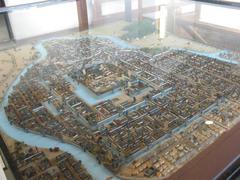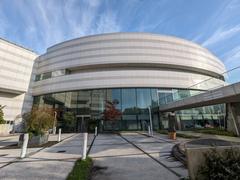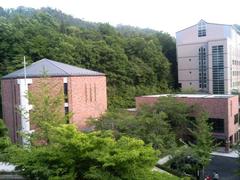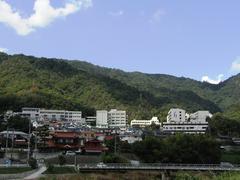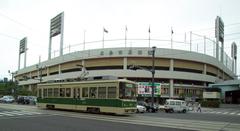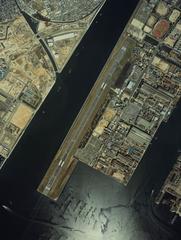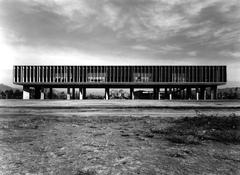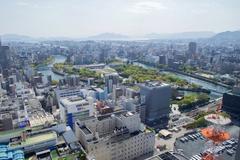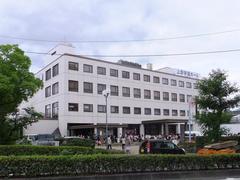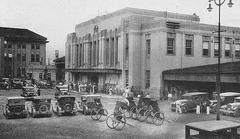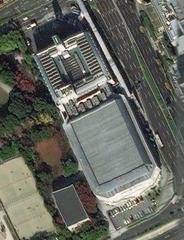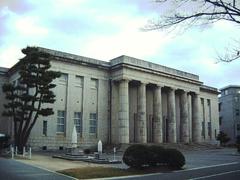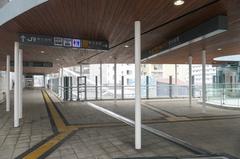Itsukaichi Interchange Hiroshima: Visiting Hours, Tickets, and Travel Guide
Date: 04/07/2025
Introduction: Itsukaichi Interchange—The Gateway to Hiroshima
The Itsukaichi Interchange, situated in Saeki-ku, Hiroshima, Japan, stands as a critical transportation hub on the Sanyō Expressway, seamlessly connecting travelers to the diverse historical, cultural, and natural attractions throughout Hiroshima Prefecture. Serving as a primary entry point for both local commuters and international visitors, the interchange links key expressways, local roads, and public transportation—making it the ideal starting point for exploring Hiroshima’s rich heritage, vibrant city life, and scenic wonders.
Itsukaichi Interchange’s modern infrastructure, featuring bilingual signage and accessible facilities, supports both efficient navigation and a welcoming travel experience. Its location provides swift access to iconic sites such as Hiroshima Peace Memorial Park, Hiroshima Castle, and the UNESCO World Heritage-listed Itsukushima Shrine on Miyajima Island. Beyond its transportation function, the surrounding area offers a blend of shopping, culinary experiences—including Hiroshima-style okonomiyaki—cultural festivals, and restful green spaces.
This guide offers a comprehensive overview of visiting Itsukaichi Interchange and nearby destinations, including essential visitor information, transportation options, top attractions, accessibility, travel tips, and practical advice for a memorable journey in Hiroshima.
For up-to-date travel details, visitors are encouraged to use resources such as the Visit Hiroshima Tourist Pass, and apps like Audiala for real-time guidance (Hiroshima City Official Overview, Itsukushima Shrine Official).
Contents
- Introduction to Itsukaichi Interchange
- Practical Visitor Information
- Transportation and Connectivity
- Top Attractions Accessible via Itsukaichi Interchange
- Tips for Visitors
- Safety, Traffic, and Seasonal Considerations
- Accessibility and Amenities
- Exploring Hiroshima: Nearby Attractions
- Visiting Itsukushima Shrine—A Comprehensive Guide
- Summary Table: Key Visitor Information
- FAQs
- Conclusion and Further Resources
1. Practical Visitor Information
Operating Hours:
The Itsukaichi Interchange operates 24 hours a day, 7 days a week, accommodating all vehicle traffic without restriction.
Tickets and Fees:
No admission ticket is required to use the interchange itself. However, tolls apply for expressway usage, and separate admission fees are charged at local attractions.
Getting There:
- By Car: Access via the Sanyō Expressway; follow signs to the Itsukaichi exit.
- By Train: Nearby JR Itsukaichi Station (Sanyō Main Line) offers direct rail links.
- By Tram: The Hiroshima Electric Railway tram network connects the area to downtown Hiroshima.
- By Bus: Local and express buses serve the interchange and adjacent neighborhoods.
Parking & Amenities:
Ample parking is available both at the interchange and at neighboring stations. Rest stops feature convenience stores, food stalls, and tourist information counters.
2. Transportation and Connectivity
The Itsukaichi Interchange is strategically positioned for rapid access to Hiroshima’s urban core, tourist hotspots, and natural getaways. It integrates with:
- Sanyō Expressway: Connecting Kobe, Hiroshima, and Yamaguchi (Wikipedia: Hiroshima Expressway).
- JR West Rail: Fast links to Hiroshima Station, Miyajimaguchi (for ferries to Miyajima), and beyond (Wikipedia: Itsukaichi Station).
- Hiroshima Electric Railway (Hiroden): An extensive tram network for urban exploration (Japan Experience: Hiroshima Trams).
3. Top Attractions Accessible via Itsukaichi Interchange
Hiroshima Castle & Sannomaru Cultural District
A short drive or tram ride brings you to Hiroshima Castle, a reconstructed feudal-era fortress surrounded by the Sannomaru Cultural District. The area offers cultural workshops, historical exhibits, and seasonal festivals (Japan Travel Note).
Hiroshima Peace Memorial Park & Atomic Bomb Dome
This UNESCO World Heritage site features the iconic A-Bomb Dome, the Peace Memorial Museum, and tranquil memorial gardens. The park is easily reachable via tram or bus from the interchange (PlanetWare).
Miyajima (Itsukushima) Island & Itsukushima Shrine
Miyajima Island is renowned for the Itsukushima Shrine and its “floating” torii gate. Access the island by driving or taking public transit to Miyajimaguchi, then boarding a ferry (Japan Guide).
Okonomi-mura
Savor local Hiroshima-style okonomiyaki at this lively food-themed arcade, located in the city center (Touropia).
Shukkei-en Garden
A historical garden designed in the 17th century, offering scenic views, ponds, and traditional tea houses (Touropia).
Mazda Museum
Car enthusiasts can tour the Mazda Museum, learning about the company’s innovations and touring the assembly lines (advance booking required) (PlanetWare).
Hiroshima City Asa Zoological Park
A family-friendly zoo with diverse animal exhibits and interactive programs, accessible within a half-hour drive (PlanetWare).
4. Tips for Visitors
- Best Seasons: Visit in spring (cherry blossoms) or autumn (vivid foliage) for pleasant weather and scenic beauty.
- Transportation Passes: The Visit Hiroshima Tourist Pass allows unlimited use of local trams, buses, and ferries.
- Guided Tours: Book tours for deeper insights into Hiroshima’s history and culture (Japan Travel Note).
- Language Support: English signage is widespread. Use translation apps for menus and directions.
- Accessibility: Most major attractions and transport modes are wheelchair-friendly, though some natural trails may be challenging (Trip to Japan).
5. Safety, Traffic, and Seasonal Considerations
- Traffic: Expect congestion during holidays like Golden Week and Obon; check real-time traffic updates (WhatsInPort).
- Weather: Summers are hot and humid; winters are mild but occasional snow is possible. June–July is the rainy season.
- Emergency Services: Rest stops near the interchange are equipped with first-aid and emergency call boxes.
6. Accessibility and Amenities
- Bilingual Signage: Japanese and English throughout the interchange and major stations.
- Rest Areas: Offer local cuisine (notably okonomiyaki), souvenirs, and Wi-Fi.
- Digital Resources: Download the Visit Hiroshima app or use Audiala for personalized navigation and tips.
7. Exploring Hiroshima: Detailed Guide to Itsukushima Shrine
Itsukushima Shrine Overview
Located on Miyajima Island, Itsukushima Shrine is celebrated for its ethereal “floating” torii gate and has been a site of worship since the 6th century. The shrine is recognized as a UNESCO World Heritage Site and is one of Japan’s most iconic landmarks (Itsukushima Shrine Official).
History and Cultural Significance
The shrine honors the three daughters of the Shinto deity Susanoo-no-Mikoto. Its unique stilted architecture, set over water, symbolizes the divide between the spiritual and physical worlds. The annual Kangen-sai Music Festival is a major cultural event, featuring traditional court music performed on boats.
Visiting Hours and Admission
- Opening Hours: 6:30 AM – 6:00 PM (varies seasonally)
- Admission: ¥300 for adults; discounts for children and seniors; free for children under 6
- Guided Tours: Available with advance booking through local agencies
Getting There
- By Train + Ferry: JR Sanyo Line from Hiroshima Station to Miyajimaguchi; ferry departs every 15 minutes to Miyajima Island (10 minutes crossing)
- By Car: Exit at Itsukaichi Interchange, proceed to Miyajimaguchi, and park near the ferry terminal
- Accessibility: The shrine and ferries are wheelchair-friendly
What to See and Do
- Floating Torii Gate: Best viewed at high tide
- Main Shrine Complex: Explore elegant halls and stages
- Daisho-in Temple: A peaceful Buddhist temple nearby
- Mount Misen: Hiking trails and panoramic views
Special Events
- Kangen-sai Music Festival (June)
- Seasonal Cherry Blossom Viewing
Photography Tips
- Early morning and late afternoon light is ideal
- High tide provides the best floating effect for the torii gate
FAQs
- Are there visiting restrictions? Respect the sacred atmosphere; some areas may restrict photography
- Is the shrine open year-round? Yes, but some events are seasonal
- Parking on Miyajima? Private vehicles are restricted; use parking at Miyajimaguchi
Related Attractions
- Hiroshima Peace Memorial Park
- Hiroshima Castle
- Shukkei-en Garden
Useful Links
- Itsukushima Shrine Official Website
- Trip to Japan: Itsukushima Shrine Guide
- CruiseMapper: Hiroshima Port
8. Summary Table: Key Visitor Information
| Topic | Details |
|---|---|
| Interchange Hours | 24/7 (vehicle access) |
| Expressway Toll | Applicable |
| Attraction Tickets | Required for sites (e.g., shrine, castle) |
| Miyajima Ferry | Every 15 minutes from Miyajimaguchi |
| Accessibility | Wheelchair-accessible at major sites |
| Best Seasons | Spring, Autumn |
| Transport Passes | Visit Hiroshima Tourist Pass |
| Guided Tours | Available, book in advance |
9. Frequently Asked Questions (FAQ)
Q: Is Itsukaichi Interchange open at all times?
A: Yes, it operates 24/7 for vehicle access.
Q: Do I need a ticket to use the interchange?
A: No, but expressway tolls apply.
Q: Are public transport and parking available?
A: Yes, both are widely available.
Q: How do I reach Miyajima from the interchange?
A: Drive or use public transport to Miyajimaguchi, then take a ferry.
Q: Is the area accessible for people with disabilities?
A: Yes, most facilities and attractions are equipped for accessibility.
10. Conclusion and Further Resources
The Itsukaichi Interchange is not just a transportation hub—it’s a pivotal gateway to Hiroshima’s rich tapestry of historical sites, cultural experiences, and natural beauty. With integrated road, rail, and tram connections, along with plentiful amenities, the interchange provides convenient and reliable access to world-renowned landmarks and hidden local gems. Whether you’re exploring the solemn grounds of Hiroshima Peace Memorial Park, the spiritual ambiance of Itsukushima Shrine, or the lively streets of downtown Hiroshima, starting your journey at Itsukaichi Interchange ensures a smooth and rewarding experience.
For detailed maps, event schedules, and real-time updates, consult the official resources below. Enhance your journey by downloading travel apps like Audiala and the Visit Hiroshima app, and follow local tourism boards on social media for the latest news and inspiration.
Reliable Sources and Further Reading
- Hiroshima City Official Overview
- Japan Travel Note: Exploring Hiroshima
- Dive! Hiroshima: Official Tourism Guide
- Itsukushima Shrine Official
- Japan Experience: Hiroshima Trams
- Wikipedia: Itsukaichi Station
- Wikipedia: Hiroshima Expressway
- WhatsInPort: Hiroshima
- PlanetWare: Hiroshima Attractions
- Japan Guide: Miyajima Island
- Touropia: Attractions in Hiroshima
- MLIT: Hiroshima Cruise Port
- Trip to Japan: Hiroshima Transport Tips
- Tourist Places Guide: Itsukaichi
- About2Cruise: Hiroshima Cruise Port Guide
- Japan Travel: Hiroshima Access Guide
- Japan Travel: Hiroshima Events
- CruiseMapper: Hiroshima Port
Images: Consider including maps showing the interchange’s location, signage examples, and photos of major attractions with descriptive alt text for enhanced accessibility.
